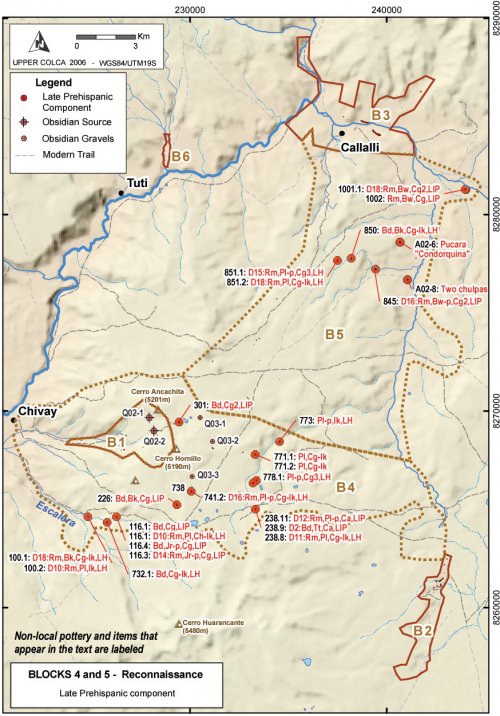Block 4 and 5 Reconnaissance Area
During the Middle Horizon, LIP and Late Horizon in the high altitude reconnaissance area near the Chivay source, several clusters of sites were observed that testify to the variety of lands used by pastoralists in this period. During the 2003 survey non-local Inka ceramics were encountered even in small, distributed pastoral sites, a higher frequency of use of obsidian with heterogeneities (Ob2), and a spatially distributed occupation pattern. These distributions perhaps reflect the growing herd sizes in the Collagua domain during the Late Prehispanic, and the need to exploit the resources in the puna as they become seasonally available.

Figure 6-71. Blocks 4 and 5 Reconnaissance - Late Prehispanic component.
An example of this distributed occupation pattern was apparent in the arid area on the south-east flanks Cerro Hornillo. Surveying across this arid area, the 2003 survey team encountered a settlement close to two ponds A03-738 "Lecceta 1" consisting of two small rock shelters and open air sites containing LIP and LH ceramics. The site includes a light scatter of obsidian flakes over the larger region, and two sectors with medium and high density obsidian scatters. The interesting thing about this site is the high incidence of use of Ob2 obsidian.
Between 500m and 1000m north of this settlement surveyors encountered surface obsidian lag gravels eroding from the base of the south-east flank of Hornillo in a formation that appears to represent a secondary obsidian quarry area. In fact, on further investigation of the source materials, it was noted that much of the obsidian on this side of Hornillo had heterogeneities (Ob2) consisting of <1 mm air bubbles trapped in the glass, as well as what appear to be ash particles. The nodules in this area were as large as 15cm long, but the typical large nodule for the area was only < 8 cm on a side. It seemed like the larger nodules had more Ob2 heterogeneities, as if perhaps there had been a preferential collection of large Ob1 nodules from this area.
The site of Lecceta 1 [A03-738] had unusually high levels of use of Ob2 obsidian. The Ob2 material was being knapped more extensively than anywhere else in the survey area.
|
Form |
Ob1 - homogeneous |
Ob2 - heterogeneous |
||||||
|
At site A03-738 |
Project surface collection |
At site A03-738 |
Project surface collection |
|||||
|
Tools |
2 |
100.0 |
290 |
92.7 |
- |
- |
23 |
7.3 |
|
Cores |
17 |
70.8 |
201 |
84.5 |
7 |
29.2 |
37 |
15.5 |
|
Flakes |
17 |
60.7 |
201 |
84.5 |
11 |
39.3 |
101 |
21.4 |
|
Total |
36 |
66.7 |
861 |
84.2 |
18 |
33.3 |
161 |
15.8 |
Table 6-55. Ob1 and Ob2 obsidian use at A03-738 "Lecceta 1" compared with entire project.
While there were more Ob1 cores, flakes, and tools collected at A03-738, there was a fair amount of reduction was occurring on the Ob2 material that was available near this camp. In particular, Ob2 cores and flakes are used at a much higher percentage in this site on than on average for the project on the whole. Given the Late Horizon evidence from this site, these data could be interpreted as supporting the notion that during the Late Prehispanic the acquisition of "high quality" obsidian, represented by Ob1 material, was deprioritized because obsidian was primarily used for the basic pastoral functions of butchering and shearing.
